
Presentation for entering Stereoscopic Photography Exhibitions
Image Appeal (Visual Impact) is what catches the eye of the judges in a photography exhibition. This may be characterized as the interest a photograph generates when viewed by anyone other than the photographer. Photographs with strong image appeal incorporate elements that attract the viewers' attention in a split second. Conversely, photographs with poor image appeal incorporate elements that repel the viewers' attention.

In addition to the elements that effect image appeal in flat photography, stereoscopic photography has positive and negative elements that contribute to either comfortable or uncomfortable stereo viewing.
In top level competition, the family snapshot or a nice landscape will be hard pressed to carry an immediate impact with the judges. They are looking for the less familiar - something more unusual. If the fused stereo image causes them any visual disturbance during those first few seconds, the game is lost regardless of how many elements that may exist that would generate positive image appeal in flat photography.
When all things are equal from an objective and technical viewpoint, it will come down to other measures to choose the most deserving and artistic stereo image. 'Does the image work?', 'Does it tell a story?', "Is there a main point of interest?'. But it has to be recognised that this is not always so and that sometimes luck can play a role in the result.
In stereoscopic photography exhibitions the most common issue that causes a stereo photograph (stereogram) to be penalised, if not rejected, during initial judging is the presence of window violations. If you don't want your stereogram to fail at this first hurdle you need to understand what these are.
Understanding and eliminating Stereo Window Violations
A stereo window violation occurs when an object appears in front of the stereo window and is cut off by the window. It's a physical impossibility that a window frame, seemingly appearing behind the object, is able to obscure it. Usually, this paradox is not well processed by our brains and such the image causes visual disturbances. Window violations on the left and right edges of a stereogram should be especially avoided as this is where this spatial conflict is perceived the most.
A stereo window violation should not be confused with when an object is in front of the window but does not touch the window edges, creating a "through the window effect". Through the window effects often give a more dramatic appearance to a stereoscopic photo and make them more interesting to view.

Window Violations
The left-hand image of the Lume Pad 2 tablet above demonstrates the "through the window effect" whilst the right-hand image contains multiple stereo window violations that cause visual disturbances. The extended hand, helmet, flowers and petals extending out from the screen in the left-hand image are cut off by the window in the right-hand image, creating a spatial conflict in our brain when viewed in stereo.
The following examples of good and bad placement of objects relative to the stereo window are based on diagrams created by the late Allan Griffin

Positioned just behind the Stereo Window (Good) L-R-L

Positioned through the Stereo Window (Good) L-R-L

Cut off by the Stereo Window (Violation) (Bad) L-R-L
Understanding Comfortable Stereo Viewing
The second most common technical reason that causes a stereo photograph (stereogram) to be penalised, if not rejected, during initial judging is the presence of excessive Positive or Negative Parallax (lateral deviation) that makes the stereogram uncomfortable to view.
Most effective Viewing Distance for a comfortable 3D viewing experience
What determines the ideal distance to view a stereoscopic image? To understand that we need to look at the Human Visual Field. Colour discrimination in limited to the inner 60 degrees of the human visual field and, unless you are looking at monochromatic stereograms, there is marginal benefit in exceeding this range.
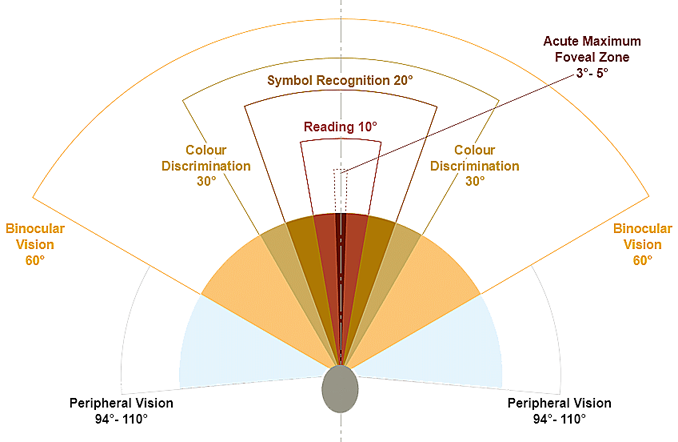
Monocular Visual Field
'Guidelines' used by the Film Industry for Comfortable Stereo Viewing
There is no coincidence that most films in stereo are mastered to give viewers just over a 60-degree field of view. These films aim to have an average lateral displacement of 2% of the screen width and only exceed this range for occasional short periods. Another recommendation is that Negative Parallax should not exceed 20%. This means that the closest foreground object should not "pop out" through the stereo window/screen more than 20% of the depth range. These recommendations are widely accepted as delivering a comfortable 3D viewing experience.

Negative versus Positive Parallax
To set the stereo window/screen at this optimal range of view requires a viewer to position themselves at a distance that is twice the width of the viewing device being used. For a 65" Screen, this equates to a viewing distance of 8.2' (2.88 m) relative to the fixed lateral screen width of 4.1' (1.44m).

Optimal Stereo Window / Viewing Screen placement in the Binocular Visual Field
With the optimal viewing distance being understood, we then need to understand what is the maximum amount of lateral displacement (parallax) that can be comfortably tolerated.
The breaking of fusion, or difficulty in maintaining fusion, is the primary factor that drives uncomfortable stereography and is almost always related to excessive parallax or lateral deviation. This is a consequence of the utilisation of wrong technical procedures in the production, post-production and exhibition stages.
The average human can support, without stress, up to 1.0 degree of divergence (0.50 degrees for each eye). If a stereogram requires the viewer to diverge their eyes outside of this range (IPD +1.0°), then it will be uncomfortable to view.
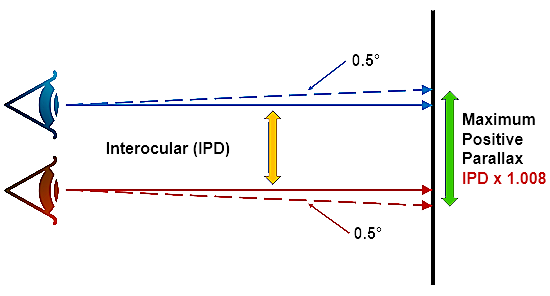
The following histogram shows the measured variation in Inter Pupillary Distance (IPD) for adult humans followed by the summary statistics.
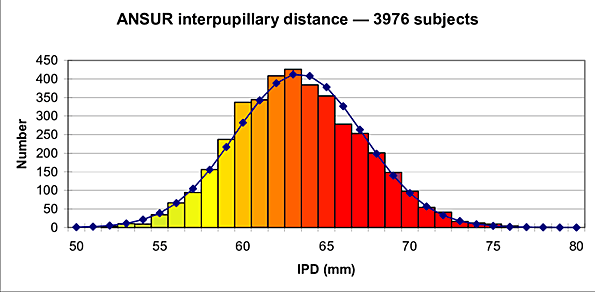
IPD Variance Histogram

IPD Variance Summary Statistics
By using the mean and standard deviation values, we can derive the following:
99.99% of the adult population have an IPD > 48 mm
99.85% of the adult population have an IPD > 52 mm
97.5% of the adult population have an IPD > 56 mm
84% of the adult population have an IPD > 59 mm
To determine the maximum amount of lateral displacement (parallax) that can be comfortably tolerated by 99.99% of people, we need to use an IPD of 48 mm as the basis for the calculations. Add to this an allowance for +1.0° of comfortable divergence gives an adjusted value of 48.4 mm. The following table shows that an IPD of 48 mm IPD allows a maximum deviation of 3.3% before viewing becomes uncomfortable for those with the minimum IPD. This aligns with the "1 in 30 rule". So now we have an understanding of the origin of this rule.
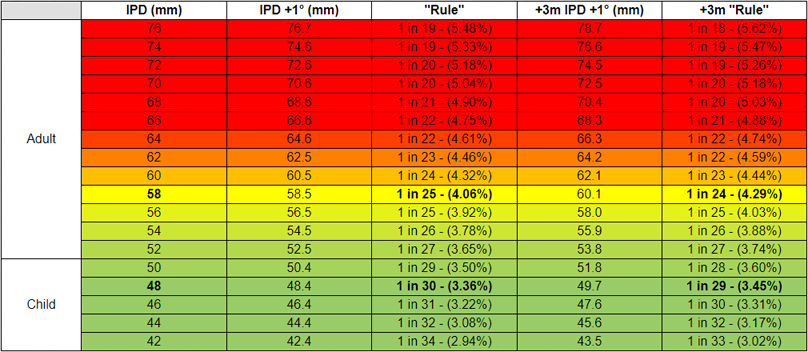
IPD Variance and maximum comfortable parallax tolerance
"1 in 30 rule" Enforcement
Should the "1 in 30 rule" be rigidly enforced by the judging panel in a Stereoscopic Photography Exhibition? This is highly debatable as there are many images that can be comfortably viewed that break this "rule" for the majority of the population. The stronger argument would be that deviations of up 4.08% should be readily accepted without penalty so long as the image is comfortable to view. This value could extend up to 5.48%, again with the proviso that the image is comfortable to view.
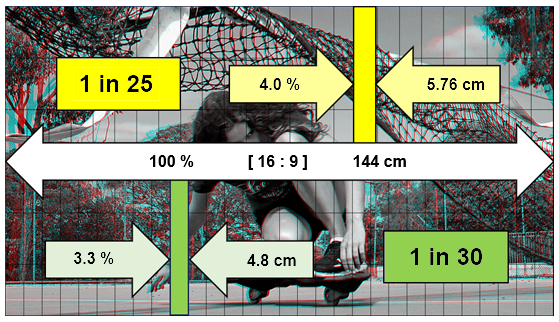
"1 in 30 rule" versus "1 in 25 rule"
In Summary
Removing any Stereo Window Violations and Excessive Positive or Negative Parallax (lateral deviation) that causes uncomfortable viewing will improve presentation and the chances of an image being accepted by a Stereoscopic Photography Exhibition.
...
Jeff Ewen 3D - creating real digital stereoscopic photographs.
Contact me by clicking here.